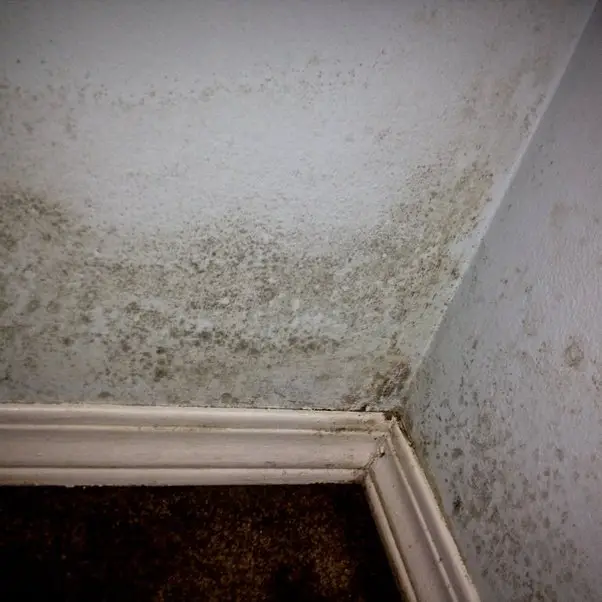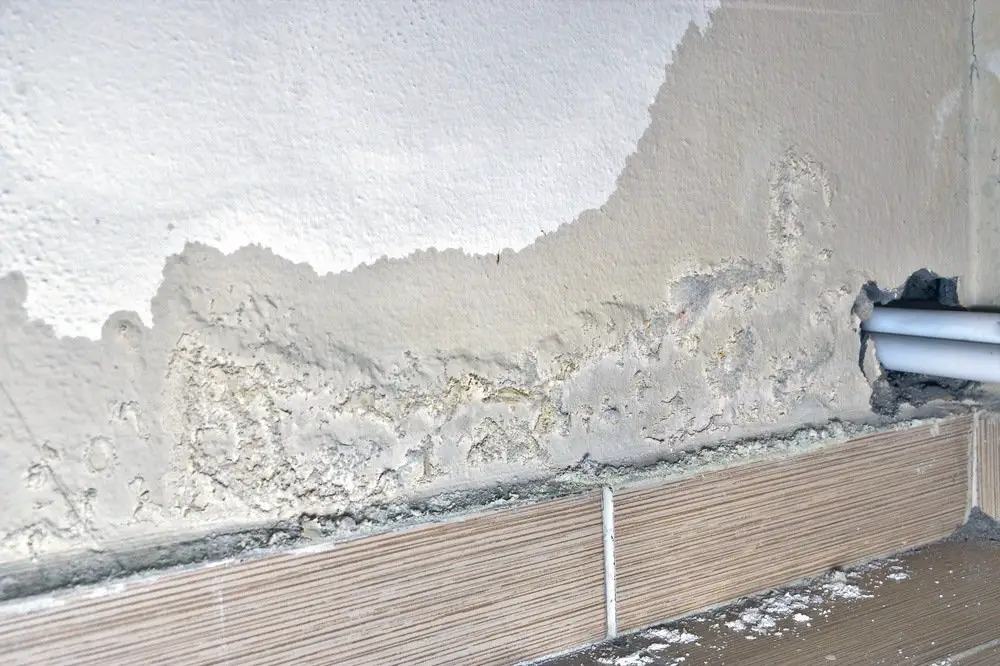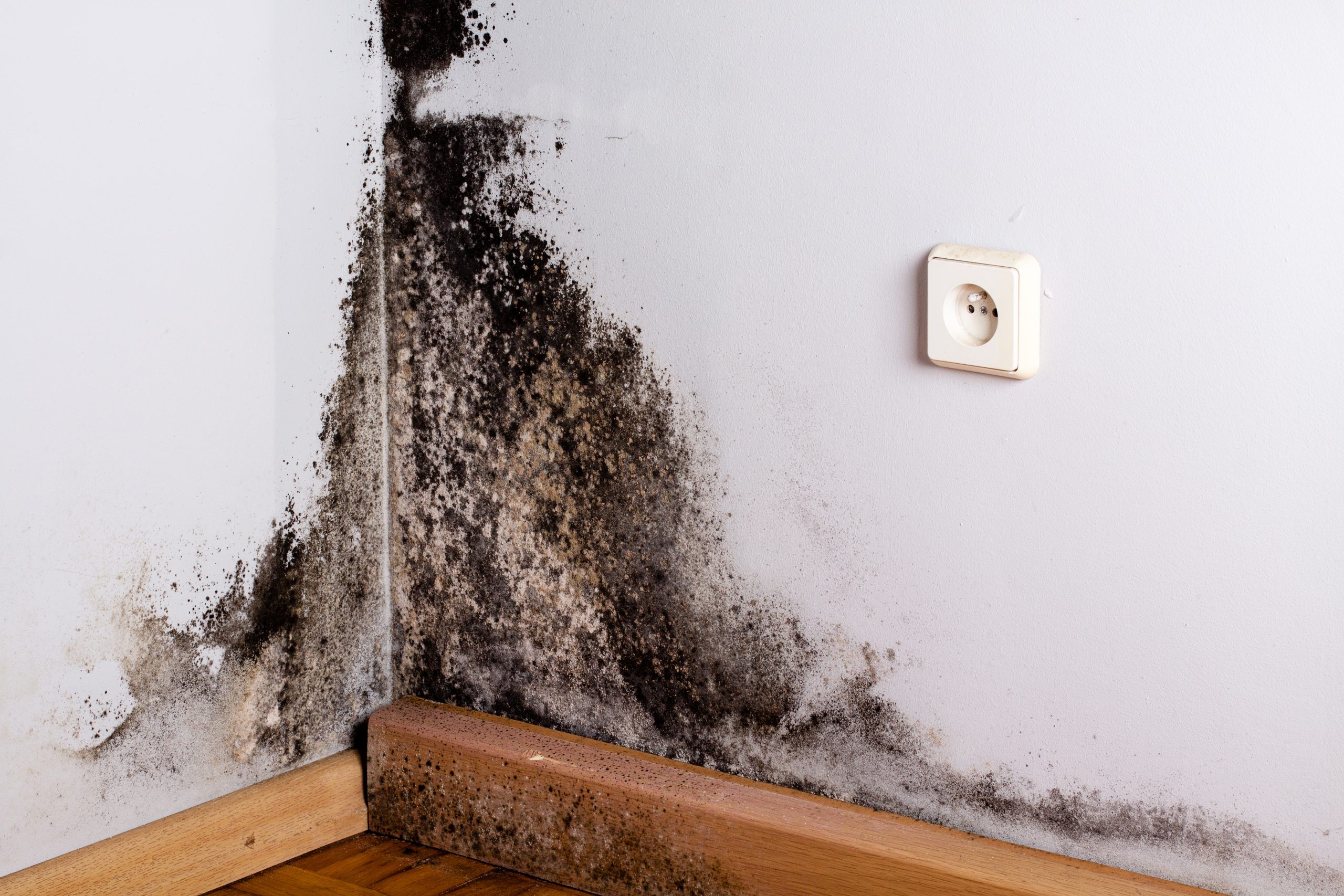Dealing With Mold In Walls
Before beginning the job of removing mold from the inside of walls, you need to cover doorways, air vents, and other openings to other parts of the home with plastic. If youre working in a large room, you can use large sheets of plastic to block off a smaller area in which you will be working. This prevents the spread of mold spores to other areas of the home. Mold remediation experts often recommend setting up negative pressure in the work area, as well.
Remove moldy drywall and insulation. Use a spray bottle of water to dampen moldy materials before removing them this helps prevent mold spores from becoming airborne during the process. When sawing through moldy drywall, you can have an assistant hold a vacuum hose with a HEPA filter nearby to further decrease the spread of mold spores. Enclose moldy materials in heavy plastic garbage bags before carrying it out of the home so no mold spores are spread to other areas of the home in the process. Its imperative that you do everything possible to prevent spreading mold spores throughout the house so that you dont end up with mold in other rooms.
Mold Removal From Fabric
Its easier than you might think for clothes to attract mold and mildew. A forgotten load of laundry in the washing machine, the pile of clothes at the bottom of a closet, or even the armchair in a humid room can all quickly become overrun with mold. However as long as you catch the problem early, your fabrics can still be saved.
Bleachable fabrics
If you can apply bleach to a fabric without worrying about discoloration, do it. Thats the fastest and most effective way of getting rid of mold. Many laundry bleaches can be used on white and colorfast fabrics, although you should always check the instructions, and never use bleach on wool or silk. Simply apply a solution of one part bleach to three parts water and let it absorb into the fabric for a few minutes before laundering as usual.
Non-bleachable fabrics
For fabrics that cant be bleached, use white vinegar instead. Either apply white vinegar to a cotton pad and place it on top of the stain for five minutes before laundering, or briefly soak in a solution of ¼ cup vinegar to one gallon water. Rinse through to remove the vinegar and launder as normal.
Upholstery
Related: All about cleaning fabrics
Where Youll Find It Growing
Mold on your basement or exterior walls occurs when water vapor in the air meets a cold surface and turns the vapor into a liquid. Bathrooms and laundry rooms develop mold because theyre typically very humid. Other humid areas include the walls and ceiling near humidifiers and any room with a hot tub or jacuzzi improperly installed indoors.
Mold also grows where there is a water leak. Places like the cupboards under sinks are prone to mold. Once a pipe has leaked, theres a good chance mold will grow unnoticed within the wall until the problem requires expert removal.
Recommended Reading: How To Tell If Mold Is Active
Your Complete Guide To Getting Rid Of Bathroom Mold
Mold is an ugly four-letter word that is found all too often in bathrooms. Learn the best ways to remove bathroom mold and prevent it from coming back.
With warm, humid conditions, the bathroom is the perfect place for mold, and it can grow on just about every surface. Once you find it, cleaning mold in the bathroom can be a big chore. Follow our tips for cleaning moldincluding products to use, instructions for specific surfaces, and key prevention tacticsto refresh your bathroom. Youll want to make sure you get it all so you arent constantly fighting mold in the bathroom.
Editors Tip: If you suspect your bathroom has black mold, known as Stachybotrys chartarum, seek a professional to test it, as you may have a larger problem at hand. If the results indicate other common household molds, move forward with our cleaning tips.
How Long Does It Take For Vinegar To Kill Mold

The general consensus is that it takes roughly one hour for vinegar to fully kill mold. While vinegar is potent enough to do the job, it needs plenty of time to break down mold spores.
While dealing with a mold outbreak on your drywall ceiling might seem like a challenge, its very doable with the right tips and preparation. Safety should always be top priority when dealing with mold, so its important to make sure your work area is well ventilated and that your eyes, airways and skin are protected from both mold spores and your cleaning chemicals.
Don’t Miss: Can Mold Cause Health Issues
What Can You Do To Prevent Mold In A Basement
To prevent mold from reoccurring or growing at all, you can take the following steps:
How To Remove Mold From Walls And Ceilings
The bad news: If the surface is very porous, like a ceiling tile, it’s best to replace it. The good news: If you find small areas of mold on walls or ceilings of sheetrock or plaster, you can stop mold when it starts if you act fast. Here’s how:
- Clean the surface with detergent and water using a sponge or brush and let the surface dry completely.
- Follow with a water and bleach solution: Mix ¾ cup of chlorine bleach to a gallon of warm water. Wearing rubber gloves, apply the water-bleach mixture to the stains with a sponge or brush.
- Let sit five minutes, scrub, rinse, and air dry.
Also Check: Where To Get Crown Molding
Using Hydrogen Peroxide Vinegar
Hydrogen peroxide has antifungal, antiviral, and antibacterial properties great for killing fungi . When hydrogen peroxide and distilled white vinegar are combined, the solution becomes more durable and safer to use in removing Mold, as it does not produce poisonous gases or leave toxic residues as bleach does. Studies have shown that white vinegar kills 82 percent of mold spores. In addition, its effervescent properties make it more effective than bleach in removing Mold from porous surfaces. On porous and non-porous walls, hydrogen peroxide can be used.
According to ServiceMaster Restoration and Cleaning, the mild acid in vinegar kills about 82% of known molds and can help prevent future outbreaks.
Pour 3 percent concentration hydrogen peroxide, undiluted, into a spray bottle and spray the affected area. Let sit on the surface for 10-15 minutes, and then scrub the walls with a brush to remove any mildew.
Walls Made Of Concrete Or Brick
Removing wall mold from walls made of concrete or brick is usually pretty simple. You can purchase antimicrobial cleansers at most home improvement stores . Scrub the moldy area with the antimicrobial cleanser with scrub brush or rag. Follow the instructions and safety precautions on the label carefully.
Sometimes it is difficult to remove all traces of mold from concrete or brick. In these cases, it may be necessary to apply a mold sealant to the surfaces after youve cleaned them as well as you can. This process, known as encapsulation, seals in any remaining traces of mold so the mold cannot grow or spread anymore. Here is more information on when to encapsulate.
Recommended Reading: What To Do If You Have Black Mold
How To Remove Mold And Mildew From Upholstery
Jack White, vice president of technical services for Rainbow International, explains whats actually going on when you see mold on your comfy couch.
Mold has to have the right conditions to grow on upholstery. First, there must be an organic food source mold cannot grow on synthetic materials but it can grow on the soil embedded in synthetic materials. There must also be moisture. The organic material has to stay wet for a certain period of time for mold to begin to grow.
Given this knowledge, here are Whites recommendations for dealing with mold on upholstery:
White also adds that silk, wool, antique or vintage upholstery should be cleaned by a professional.
Types Of Basement Mold
Various types of mold will infest your basement. While they are all hideous, not all of them are toxic to humans.
Molds can be divided into two categories:
- Allergenic
- Mycotoxin/black
Allergenic molds usually pose no health risk unless you are extremely sensitive to molds or asthmatic. Black molds, on the other hand, produce a toxic chemical called mycotoxins and are particularly harmful to humans and pets.
Here are the common types of molds that can infest your basement.
Aspergillus
Aspergillus is one of the most common household mold species. There are different types of Aspergillus, and most of them thrive well indoors. Some of the Aspergillus molds are allergenic, but some are mycotoxin and should be removed by a specialist, especially if it is something like black mold.
This fungus is dark green and found on damp walls, ceilings, and even furniture. It flourishes in humid environments, but can also grow in areas that are dry with high levels of humidity or condensation.
Also Check: How To Remove Mold Spores From Air
Signs Of Molds In Wall
What are the signs that show mold growth? Following are the signs that you must look after to avoid further problems.
- Damp smell in the room or from the affected area.
- Loss of color from the affected area.
- The appearance of Black dots, streaks, and specks.
- Bulging of the affected area.
- Peeling of paint and crack formations.
What Is Black Mold

Simply put, molds are a microscopic living organism. A single spore is so tiny that it cannot be seen by the naked eye, which means that it may be in your home and behind a wall, without you even knowing it. If you can visibly see that you have a problem, it typically means it has been there for a long period of time, because it has time to grow and spread in an area large enough to be visible. It generally grows on porous materials, such as wood, drywall, fabric and carpets however, it can also grow on non-porous materials such as tile. It needs the right conditions to grow. There has usually been some type of water damage and the area has stayed wet long enough for the spores to grow.
Act Now and Remove Mold from your HomeCall a Professional Mold Remediation Specialist or Get Up to 4 Quotes Now.
Don’t Miss: What Causes Mold In Crawl Space
In The Rest Of Your Home
Inspect appliance hoses. You should replace flexible hoses on washing machines and kitchen sink sprayers immediately if you see a leak or condensation and every five years, even if you dont spot problems. If you dont replace them on time, your homeowners or renters insurance wont pay if they burst and cause water damage. Inspect your roof after storms. Look for loose shingles or other damage that could allow water to enter your attic or home. Keep your foundation clear. Dont stack firewood or other items against your homes foundation, or youll encourage water collection there that will seep into your basement walls.
Fix cracks promptly. If you find gaps in your foundation or siding, fix them immediately to keep water out of your home. Clean your gutters in the Spring and Fall. Clogged gutters cause water to pool near your foundation, leading to water damage that causes mold.
Remember, mold wont go away on its own. If you find signs of it growing on your walls, you need to take prompt action to remove it with these easy homemade mold-killing sprays. Then keep it from coming back by controlling your homes humidity levels, promoting good air circulation, and cleaning routinely to remove mold spores.
Removing Mold From Walls With Baking Soda
Baking soda, any kind from the store or even will do, is a cheap, gentle cleaning agent to use on surface mold combine a teaspoon of liquid detergent with a cup of baking soda and add water to mix a paste. Apply to bathroom wall tiles and grout with a stiff brush , leave to soak in, then rinse off. Repeat if necessary. This is a great way to simply clean grout.
Richards comments: ‘Baking soda is effective but you have to do a lot of intense scrubbing to use it. But you can always put a layer of baking soda after the initial removal to reduce the chance of the mold coming back.’
Read Also: Is All Mold Black Mold
How To Recognize Mold In Your Basement
The first sign that you have mold in your basement is the unpleasant musty, almost earthy smell in your basement. It is similar to the wet wood smell. Once you notice the smell, look around places where mold appears.
Mold develops around pipes and vents, in the ceiling, around the dryer, and as it starts growing, it can overtake the wall. Mold will generally make the area look dirty and speckle sections with black dots or spread in irregular shapes. It can start in dark corners and work its way around to the wall and ceiling.
Mix The Mold Cleaning Solution
In a plastic bucket, mix one-part dishwashing liquid, 10 parts bleach, and 20 parts water. To clean a small area of mold, mix a solution of one tablespoon dishwashing liquid, 1/2 cup chlorine bleach, and one cup of warm water in a spray bottle. The dishwashing liquid helps the solution cling to the wall longer to kill the mold spores.
Recommended Reading: How To Remove Mold From Clothes With Vinegar
Do Not Mix Vinegar With Bleach Or Hydrogen Peroxide
Do not mix vinegar with bleach. Doing so can create toxic chlorine gas. You should also avoid mixing vinegar with hydrogen peroxide. This reaction creates a toxic chemical called peracetic acid that can potentially irritate your skin or eyes.
Even though vinegar is often an effective mold cleaner, there are many other household cleaners you can use. Here are a few other DIY options.
How To Prevent Mould And Mildew On Walls: Our Top 6 Tips
Once youâve dealt with a mildew infestation on your walls, the next step is to try to stop it recurring. Here are your options:
Buy a specialised product. An anti-microbial spray, for example, can help prevent the spores from settling again. Anti-mildew paint can also be purchased from most DIY stores.
Consider installing an electric de-humidifier in badly affected areas. This is ideal for long-term mould prevention.
Look into upgrading your home insulation. Sometimes, but not always, bad insulation is the root of the problem. Walls and ceilings that are properly insulated will be less affected by condensation and therefore mould.
The best tips on how to get rid of mould involve cutting out the damp conditions it loves so much:
Keep bathrooms, kitchens, and other humid spaces well-ventilated and as dry as possible
Spread out shower curtains and towels to dry.
Tackle leaks as soon as theyâre discovered to prevent moisture seeping into cavities and under floors.
Donât panic if the mould and mildew on walls return: this is a common occurrence, and youâre now a bit of an expert on how to treat mould on walls!
Originally published
You May Like: Can Mold Get In Your Lungs
What Is The Most Common Spot For Mold Growth
Bathrooms, laundry rooms, kitchen, basements, and showers are the common areas for mold growth. All of these have one thing in common they are wet and dont get ample drying time. Other than these areas, mold can grow anywhere.
To remove black mold out of shower curtains and shower caulk see this and this guide.
Why Does Mold Grow In The Inside Corners Of Walls

There are two possible causes for a mold problem at the inside corners of exterior walls. The first is poor air circulation. Warm air registers are normally located in front of windows so they can blow warm, dry air over the glass to cut down on condensation. Corners that are located away from this moving air, like those in closets, become cool and allow moisture to condense. The moisture is what mold and mildew thrive on. The second is uninsulated framing cavities. During cold weather, the inside wall surface cools, moisture condenses, and mildew sets up shop.
Recommended Reading: How Do You Clean Mold Off Vinyl Siding
